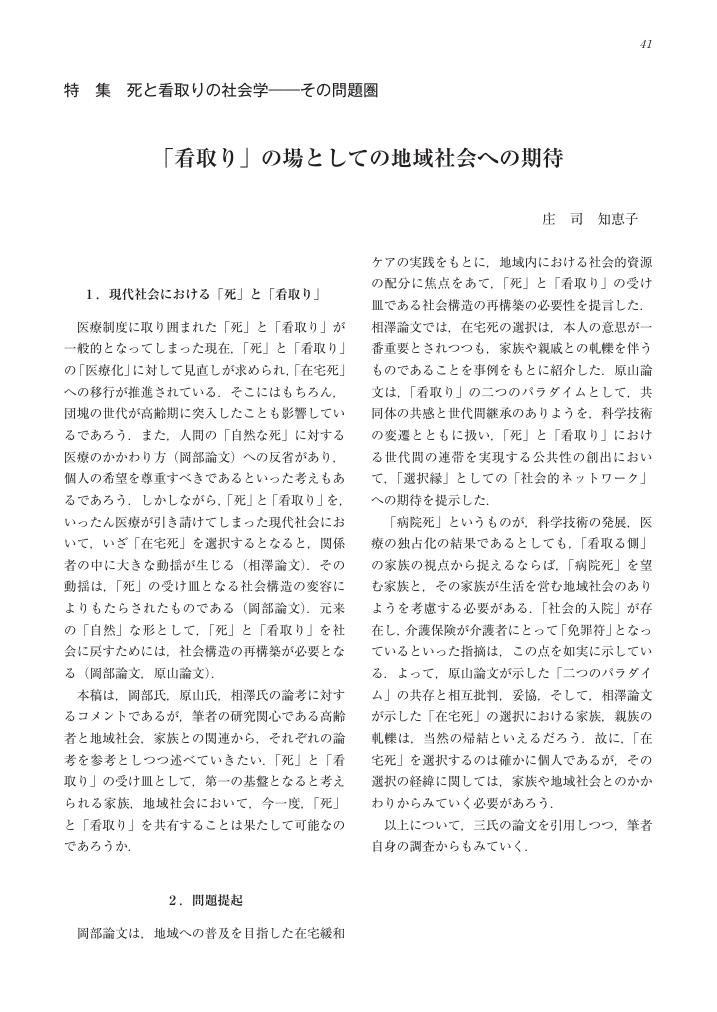3 0 0 0 「限界集落論」の現在
- 著者
- 庄司 知恵子
- 出版者
- 岩手県立大学社会福祉学部
- 雑誌
- 岩手県立大学社会福祉学部紀要 (ISSN:13448528)
- 巻号頁・発行日
- vol.13, no.22, pp.71-77, 2011-03
3 0 0 0 IR 「限界集落論」の現在
- 著者
- 庄司 知恵子
- 出版者
- 岩手県立大学社会福祉学部
- 雑誌
- 岩手県立大学社会福祉学部紀要 (ISSN:13448528)
- 巻号頁・発行日
- vol.13, no.22, pp.71-77, 2011-03
1 0 0 0 OA 【聞き書き】北上川河口地域の人と暮らし2 : 宮城県石巻市北上町の女性たち
- 著者
- 平川 全機 武中 桂 庄司 知恵子
- 出版者
- 北上川河口地域研究グループ
- 雑誌
- 【聞き書き】北上川河口地域の人と暮らし2 : 宮城県石巻市北上町の女性たち
- 巻号頁・発行日
- pp.1-64, 2014-09-01
1 0 0 0 OA 「看取り」の場としての地域社会への期待
- 著者
- 庄司 知恵子
- 出版者
- 東北社会学会
- 雑誌
- 社会学年報 (ISSN:02873133)
- 巻号頁・発行日
- vol.39, pp.41-44, 2010-07-16 (Released:2014-02-07)
- 参考文献数
- 5
1 0 0 0 IR 集落における女性の組織-観音講と念仏講- -宮城県石巻市北上町を事例として-
- 著者
- 武中 桂//庄司 知恵子 庄司 知恵子
- 出版者
- 神戸女学院大学
- 雑誌
- 女性学評論 (ISSN:09136630)
- 巻号頁・発行日
- vol.29, pp.91-118, 2015-03
This article is focused on social organizations for women "KANNON-KOU" and "NENBUSTU-KOU" in a hamlet (mura). This article explains the relationship between local women and women's social organizations. It then clarifies the gradual change in the relationship. Finally, it discusses the meaning of the gradual change.Generally there is a social organization for men called "KEIYAKU-KOU" in a hamlet. Hamlets establish some social organizations depending on gender and age. "KANNON-KOU" and "KEIYAKU-KOU" are social organizations for women. Previously, people were recognized as a member of that hamlet when they belonged to an organization there. Therefore, we can understand changes in the relationship between local women and their organizations by discussing the changes in"KANNON-KOU" and "NENBUTSU-KOU".In Kitakami-cho, "KANNON-KO" is defined as "a group of wives". Women must belong to"KANNON-KOU" when they get married with men who live in this community. This organization has a role of praying for easy childbirth. Members spend two days in a year, eating lunch and dinner together, praying God and deepening their friendship with each other. But older members were very strict on younger members. However after the Great East Japan Earthquake, "KANNON-KO" did not function at all and some of them have already been disbanded.On the other hand, "NENBUTSU-KOU" is defined as "a group of mothers-in-law". Women move to "NENBUTSU-KOU" from "KANNON-KOU" when their son(s) get married. The main purpose of "NENBUTSU-KOU' is to pray for their ancestors. While they do eat meals together in the same way as "KANNON-KOU", there is no strictness. Further, "KANNON-KOU" has continued after the Great East Japan Earthquake.Local organizations for women and the implications have gradually changed with their daily life in the hamlet. The fact that "KANNON-KOU" had already been disbanded and "NENBUTSU-KOU" continues demonstrate what is the most important thing for women's life in this hamlet.This article is focused on social organizations for women "KANNON-KOU" and "NENBUSTU-KOU" in a hamlet (mura). This article explains the relationship between local women and women's social organizations. It then clarifies the gradual change in the relationship. Finally, it discusses the meaning of the gradual change.Generally there is a social organization for men called "KEIYAKU-KOU" in a hamlet. Hamlets establish some social organizations depending on gender and age. "KANNON-KOU" and "KEIYAKU-KOU" are social organizations for women. Previously, people were recognized as a member of that hamlet when they belonged to an organization there. Therefore, we can understand changes in the relationship between local women and their organizations by discussing the changes in"KANNON-KOU" and "NENBUTSU-KOU".In Kitakami-cho, "KANNON-KO" is defined as "a group of wives". Women must belong to"KANNON-KOU" when they get married with men who live in this community. This organization has a role of praying for easy childbirth. Members spend two days in a year, eating lunch and dinner together, praying God and deepening their friendship with each other. But older members were very strict on younger members. However after the Great East Japan Earthquake, "KANNON-KO" did not function at all and some of them have already been disbanded.On the other hand, "NENBUTSU-KOU" is defined as "a group of mothers-in-law". Women move to "NENBUTSU-KOU" from "KANNON-KOU" when their son(s) get married. The main purpose of "NENBUTSU-KOU' is to pray for their ancestors. While they do eat meals together in the same way as "KANNON-KOU", there is no strictness. Further, "KANNON-KOU" has continued after the Great East Japan Earthquake.Local organizations for women and the implications have gradually changed with their daily life in the hamlet. The fact that "KANNON-KOU" had already been disbanded and "NENBUTSU-KOU" continues demonstrate what is the most important thing for women's life in this hamlet.
